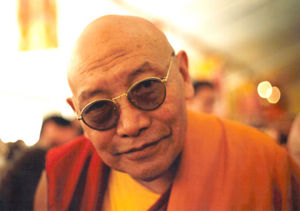Trulshik Rinpoche: Difference between revisions
m (→External Links) |
|||
| Line 61: | Line 61: | ||
==External Links== | ==External Links== | ||
*Biography | *Biography written by his nephew and chief attendant, Kusho Ngawang Tsephel. At Pamakara [https://acrobat.com/#d=lBPF7boCvNIyRwNBw*ZCmw Download here] | ||
*[http://www.songtsen.org/index.php?option=com_content&view=article&id=101&Itemid=60&lang=en Biography at Songtsen.org] | *[http://www.songtsen.org/index.php?option=com_content&view=article&id=101&Itemid=60&lang=en Biography at Songtsen.org] | ||
*[http://youtu.be/drPB75kgZ64 Richard Kohn's film ''Lord of the Dance, Destroyer of Illusion'' on youtube] | *[http://youtu.be/drPB75kgZ64 Richard Kohn's film ''Lord of the Dance, Destroyer of Illusion'' on youtube] | ||
Revision as of 21:17, 26 December 2011

Kyabjé Trulshik Rinpoche Ngawang Chökyi Lodrö (Tib. ཁྲུལ་ཞིག་ངག་དབང་ཆོས་ཀྱི་བློ་གྲོས་, Wyl. ‘khrul zhig ngag dbang chos kyi blo gros) (1924-2011) was one of the seniormost lamas of Tibetan Buddhism. Considered as the heart son of both Kyabjé Dilgo Khyentse Rinpoche and Kyabjé Dudjom Rinpoche, he became a teacher to His Holiness the Fourteenth Dalai Lama, and in 2010 the head of the Nyingma school.
Biography
Kyabjé Trulshik Rinpoche was born at Yardrok Taklung in Central Tibet on the tenth day of the ninth month in the year of the Water Rat (1924).[1] He was recognized in early childhood as the immediate re-embodiment of Tertön Dongak Lingpa (Kunzang Thongdrol Dorje) a famous discoverer of spiritual treasures and is also considered as being the manifestaion of Lord Buddha’s disciple Ananda, as well as of Aryadeva, Thönmi Sambhota, the abbot Shantarakshita, the translator Vairotsana and Rechung Dorje Trakpa.
He received his early education from his predecessor's foremost disciple, Ngawang Tendzin Norbu (1867-1942), who was known as the Buddha of Dza Rongphuk after his place of retreat and the monastery that he established on the northern slopes of Mount Everest. After Ngawang Tendzin Norbu passed away, Trulshik Rinpoche became the abbot of the monastic community, and following the tragic events of 1959 moved with his followers to safe haven in the valleys to the south of the Mount Everest area, among the Sherpa people of northeastern Nepal. Thupten Chöling, the monastery that he founded there, is today renowned as a foremost centre for the monastic traditions of the Nyingma School of Tibetan Buddhism. Since he came out of Tibet, Rinpoche has ordained nearly ten thousand monks and nuns.

Besides his root-guru, Trulshik Rinpoche's teachers have included Minling Chung Rinpoche and Dordzin Rinpoche, Dudjom Rinpoche, Jamyang Khyentse Chökyi Lodrö and especially Dilgo Khyentse Rinpoche of whom he was like a heart-son. Altogether he had some fifty masters representing all of the major lineages of Tibetan Buddhism. Over the years, he has also been offering many rare Nyingma teachings to His Holiness the Dalai Lama.
Trulshik Rinpoche is also the unique heir to some of Tibet's rarer traditions, for instance that of the "Pacification of Suffering" (Tib. Shyijé), first introduced in Tibet during the 11th century by the Indian yogin Padampa Sangye. As the present embodiment of a line of treasure-discoverers, he continues his predecessor's teachings, especially those in relations to the great master Padmasambhava and the meditational teachings of the Great Perfection or Dzogchen. Trulshik Rinpoche's unusually clear and spontaneous style of teaching is reflected in his accomplishments as a poet and master of all aspects of the monastic arts. His direction of the annual Mani Rimdu festival of masked dance-drama is documented in Richard Kohn's film Lord of the Dance, Destroyer of Illusion (1986), the title of which is in part derived from his name, Trulshik Rinpoche, "the Precious Destroyer of Illusion."
Kyabje Trulshik Rinpoche accepted in 2010 the position of the new head of the Nyingma school. The previous head, Kyabje Minling Trichen Rinpoche, passed away in 2008.
He entered parinirvana on 2nd September 2011 and remained in tukdam for three days in his monastery in Kathmandu, Nepal.
Writings
- སྲིད་ཞིའི་རྣམ་འདྲེན་གོང་ས་སྐྱབས་མགོན་རྒྱལ་བའི་དབང་པོ་ཐམས་ཅད་མཁྱེན་ཅིང་གཟིགས་པ་ཆེན་པོ་མཆོག་གི་འཁྲུངས་རབས་གསོལ་འདེབས་བྱིན་རླབས་བདུད་རྩིའི་སྤྲིན་ཕུང་, srid zhi'i rnam 'dren gong sa skyabs mgon rgyal ba'i dbang po thams cad mkhyen cing gzigs pa chen po mchog gi 'khrungs rabs gsol 'debs byin rlabs bdud rtsi'i sprin phung
- ཇོ་བོ་ཐུགས་རྗེ་ཆེན་པོའི་སྔོན་འགྲོའི་འདོན་ཁྲིགས་མུན་སེལ་སྒྲོན་མེ་, jo bo thugs rje chen po'i sngon 'gro'i 'don khrigs mun sel sgron me
- རྒྱལ་བ་སྲས་དང་བཅས་པའི་མཚན་ཕྱག་འགའ་ཞིག་མཆོག་དམན་ཀུན་གྱི་ཞལ་འདོན་དུ་བསྒྲིགས་པ་, rgyal ba sras dang bcas pa'i mtshan phyag 'ga' zhig mchog dman kun gyi zhal 'don du bsgrigs pa
Prayers & Practices Composed by Trulshik Rinpoche
- ཐུགས་རྗེ་ཆེན་པོ་ཡི་གེ་དྲུག་པའི་གསོལ་འདེབས་སྒྲུབ་ཐབས་བྱིན་རླབས་ཅན་, thugs rje chen po yi ge drug pa'i gsol 'debs sgrub thabs byin rlabs can
- Homage to the Buddhas and Bodhisattvas
Visits to the Rigpa Sangha
- 1996: blesses Lerab Ling
- 1999: teachings & empowerments
- San Francisco, 1-2 September
- New York, 12 September
- Lerab Ling, 11-14 November
- 2000:
- Lerab Ling & Lerab Gar: stays in Lerab Ling and attends His Holiness the Dalai Lama's teachings
- Rigpa centre, Levallois, 7 October
- 2003: teachings & empowerments
- Lerab Ling, 23 June-3 July
- Kirchheim, 28-31 December
- 2005: teachings & empowerments
- Lerab Ling, 1-10 December
For more details, see Empowerments Given to the Rigpa Sangha
Notes
Accounts of Trulshik Rinpoche's Life
- Sogyal Rinpoche, Rigpa Berlin Centre, 30 September 2011
Further Reading
In Tibetan
- Ngagyur Nyingma College, འོག་མིན་ཨོ་རྒྱན་སྨིན་གྲོལ་གླིང་གི་གདན་རབས་མཁན་བརྒྱུད་རིམ་པར་བྱོན་པ་རྣམས་ཀྱི་རྣམ་ཐར་གཡུལ་ལས་རྣམ་པར་རྒྱལ་བའི་དགའ་སྟོན་, 'og min o rgyan smin grol gling gi gdan rabs mkhan brgyud rim par byon pa rnams kyi rnam thar g.yul las rnam par rgyal ba'i dga' ston, Ngagyur Nyingma College, 2002, pp. 187-189
In English
- Hugh R. Downs, Rhythms of a Himalayan Village, Delhi: Book Faith India, 1996
- Rigpa Journal, September 2000, 'Kyabjé Trulshik Rinpoche'
Internal Links
- Prayer for the Long Life of Trulshik Rinpoche by His Holiness the Dalai Lama
- Trulshik Rinpoche's Lineage of Nyingtik Yabshyi
- Trulshik Rinpoche's previous incarnations
External Links
- Biography written by his nephew and chief attendant, Kusho Ngawang Tsephel. At Pamakara Download here
- Biography at Songtsen.org
- Richard Kohn's film Lord of the Dance, Destroyer of Illusion on youtube
- Documentary on the construction of Trulshik Rinpoche's new monastery in Nepal
 Trulshik Rinpoche Series on Lotsawa House
Trulshik Rinpoche Series on Lotsawa House